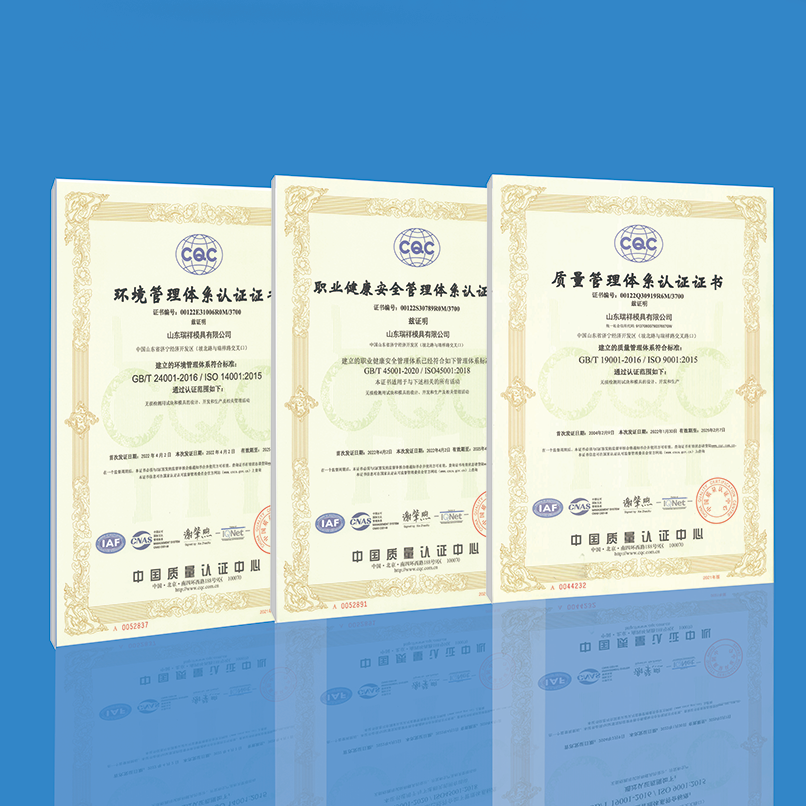five preventive measures for hardening cracks in die steel -欧洲杯在线买球平台
1. longitudinal cracks
the crack is axial, thin and long in shape. when the die is fully quenched, that is, when the quenching is unintentional, the heart is transformed into the quenched martensite with the largest specific volume, resulting in tangential tensile stress. the higher the carbon content of the die steel, the greater the tangential tensile stress generated. when the tensile stress is greater than the strength limit of the steel, the longitudinal crack is formed. the following factors further aggravate the occurrence of longitudinal cracks:
(1) steel contains more s, p, bi, pb, sn, as and other low melting point harmful impurities, the ingot rolling along the rolling direction of the longitudinal severe segregation distribution, easy to produce stress concentration to form longitudinal quenching cracks, or raw materials after rolling fast cold longitudinal cracks are not processed and retained in the product, resulting in the final quenching crack expansion and formation of longitudinal cracks;
(2) the mold size is easy to form longitudinal cracks when the quenching crack sensitive size range of steel (the quenching crack risk size of carbon tool steel is 8-15mm, and the risk size of medium and low alloy steel is 25-40mm) or the selected quenching cooling medium greatly exceeds the critical quenching cooling speed of the steel.
preventive measures:
(1) strictly check the storage of raw materials, and do not put into production steel with excessive harmful impurities;
(2) try to use vacuum smelting, off-furnace refining or electroslag remelting mold steel;
(3) improve the heat treatment process, using vacuum heating, protective atmosphere heating and fully deoxidized salt bath furnace heating and fractional quenching, isothermal quenching;
(4) change the centerless quenching to the core quenching, that is, incomplete quenching, obtain the lower bainite structure with high strength and toughness, greatly reduce the tensile stress, and effectively avoid the longitudinal cracking and quenching distortion of the mold.
2. transverse crack
the crack feature is perpendicular to the axial direction. in the unquenched die, there is a large peak tensile stress in the transition part between the hardened zone and the unquenched zone, and it is easy to form a large peak tensile stress during rapid cooling of the large die, because the formed axial stress is greater than the tangential stress, resulting in transverse cracks. transverse segregation of low melting point harmful impurities such as s, p, bi, pb, sn, as in the forging module or transverse microscopic cracks exist in the module, and transverse cracks are formed by extension after quenching.
preventive measures:
(1) the module should be reasonably forged, the ratio of the length and diameter of the raw material, that is, the forging ratio is best selected between 2-3. the forging adopts double-dec-shaped directional forging, and the forging adopts five-upset and five-pull multi-fire forging, so that the carbides and impurities in the steel are fine and small, evenly distributed in the steel matrix, and the forging fiber organization is distributed aimless around the cavity, which greatly improves the transverse mechanical properties of the module and reduces and eliminates the stress source;
(2) choose the ideal cooling speed and cooling medium: the fast cooling above the ms point of the steel is greater than the critical quenching cooling rate of the steel, the stress generated by the supercooled austenite in the steel is the thermal stress, the surface is the compressive stress, the inner layer is the tensile stress, which counteracts each other, effectively prevents the formation of thermal stress cracks, and the slow cooling between the ms-mf of the steel greatly reduces the organizational stress during the formation of quenched martensite. when the sum of thermal stress and corresponding stress in steel is positive (tensile stress), it is easy to quench crack, and when it is negative, it is not easy to quench crack. making full use of the thermal stress, reducing the phase change stress and controlling the total stress to be negative can effectively avoid the occurrence of transverse quenching cracks. cl-1 organic quenching medium is an ideal quenching agent, which can reduce and avoid the distortion of quenching die and control the reasonable distribution of hardening layer. adjusting the different concentration ratio of cl-1 quenching agent can obtain different cooling speed, obtain the required hardening layer distribution, and meet the needs of different die steel.
3. arc crack
it often occurs in the shape mutation of mold corners, notches, holes, and die wiring flash edges. this is because the stress generated at the corners during quenching is 10 times the average stress on the smooth surface.
in addition,
(1) the higher the carbon (c) content and alloying element content in the steel, the lower the ms point of the steel, the ms point decreased by 2℃, the quenching cracking tendency increased by 1.2 times, the ms point decreased by 8℃, the quenching cracking tendency increased by 8 times;
(2) the different microstructure transformation and the same microstructure transformation in steel are not simultaneous, due to the specific tolerance of different tissues, resulting in huge microstructure stress, resulting in the formation of arc cracks at the junction of tissues;
(3) after quenching is not tempered in time, or tempering is not sufficient, the residual austenite in the steel is not fully transformed, retained in the use state, promote the redistribution of stress, or the martensitic transformation of the residual austenite when the mold is in service generates new internal stress, and arc cracks are formed when the comprehensive stress is greater than the strength limit of the steel;
(4) with the second type of tempered brittle steel, tempering slow cooling after quenching, resulting in p, s and other harmful impurity compounds in the steel precipitate along the grain boundary, greatly reducing the grain boundary binding force and strength and toughness, increasing brittleness, and forming arc cracks under the action of external forces during service.
preventive measures:
(1) improve the design, try to make the shape symmetrical, reduce the shape mutation, increase the process hole and reinforcement, or use a combination assembly;
(2) round corner generation right angle and sharp edge, through the hole generation blind hole, improve processing accuracy and surface finish, reduce stress concentration source, for can not avoid right angle, sharp edge, blind hole and other general hardness requirements are not high, can be wrapped or filled with iron wire, asbestos rope, refractory mud, artificially caused cooling barrier, slow cooling quenching, to avoid stress concentration, prevent the formation of arc cracks during quenching;
(3) the quenched steel should be tempered in time to eliminate part of the quenched internal stress and prevent the expansion of the quenched stress;
(4) tempering for a long time to improve the fracture toughness of the mold;
(5) fully tempered to obtain stable organizational properties; multiple tempering makes the residual austenite transform fully and eliminates the new stress;
(6) reasonable tempering to improve fatigue resistance and comprehensive mechanical properties of steel parts; for the second type of tempered brittle die steel after high temperature tempering should be quickly cooled (water cooled or oil cooled), can eliminate the second type of tempered brittleness, to prevent and avoid the formation of arc cracks during quenching.
4. peeling cracks
when the die is in service, under the action of stress, the hardened layer is stripped from the steel matrix. due to the difference in the specific volume of the mold surface structure and the core structure, axial and tangential quenching stress is formed on the surface surface during quenching, radial tensile stress is generated, and it changes internally, and peeling cracks are generated in the narrow range of sharp changes in stress, which often occurs in the cooling process of the mold after surface chemical heat treatment. due to the different synchronization between the surface chemical modification and the steel matrix transformation, the quenching martensite expansion of the inner and outer layers is not carried out at the same time, resulting in large phase transformation stress, which leads to the chemical treatment of the permeated layer from the matrix structure. such as flame surface hardening layer, high frequency surface hardening layer, carburizing layer, carbonitriding layer, nitriding layer, boriding layer, metallizing layer, etc. chemical infiltration layer quenching should not be rapid tempering, especially 300 ~ c below the low temperature tempering rapid heating, will promote the surface to form tensile stress, and the steel matrix core and transition layer to form compressive stress, when the tensile stress is greater than the compressive stress, resulting in chemical infiltration layer is stretched off.
preventive measures:
(1) the concentration and hardness of the chemical permeation layer of the die steel should be gently reduced from the surface to the inside, and the binding force between the permeation layer and the matrix should be enhanced.
(2) before chemical treatment of die steel, diffusion annealing, spheroidizing annealing and tempering treatment are carried out to fully refine the original structure, which can effectively prevent and avoid the occurrence of peeling cracks and ensure product quality.
5. mesh cracks
the depth of the crack is shallow, the general depth is about 0.01-1.5mm, and it is radial, alias crack.
the main reasons are:
(1) the raw material has a deep decarburization layer, which is not removed by cold cutting processing, or the finished mold is heated in the oxidizing atmosphere furnace to cause oxidation and decarburization;
(2) mold decarburization surface metal structure and steel matrix martensitic carbon content is different, the specific volume is different, steel decarburization surface quenching produce large tensile stress, therefore, the surface metal is often pulled along the grain boundaries into a network;
(3) the raw material is coarse grain steel, the original structure is coarse, there is a large block ferrite, conventional quenching can not be eliminated, retained in the quenched structure, or temperature control is not accurate, instrument failure, the occurrence of tissue overheating, or even over-burning, grain coarsening, loss of grain boundary bonding force, mold quenching cooling steel carbide precipitation along the austenite grain boundary, grain boundary strength is greatly reduced, poor toughness, brittleness, under tensile stress, a network fracture occurs along grain boundaries.
preventive measures:
(1) strict chemical composition of raw materials. metallographic structure and inspection, unqualified raw materials and coarse grain steel should not be used as mold materials;
(2) the selection of fine grain steel, vacuum electric furnace steel, review the depth of raw material decarburization layer before production, cold cutting processing allowance must be greater than the depth of decarburization layer;
(3) develop advanced and reasonable heat treatment process, choose a microcomputer temperature controller table, control accuracy of ±1.5℃, and check the instrument on site at regular times;
(4) the final treatment of mold products uses vacuum electric furnace, protective atmosphere furnace and fully deoxidized salt bath furnace to heat mold products and other measures to effectively prevent and avoid the formation of mesh cracks.









